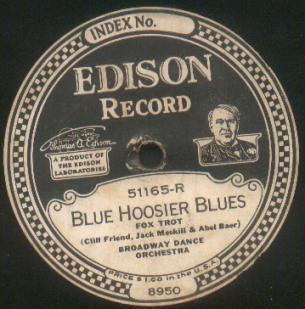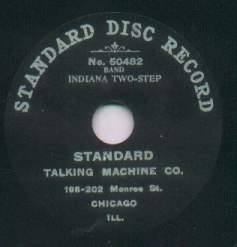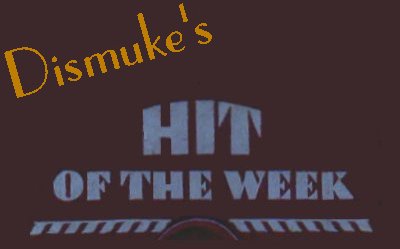

April 2002
April 25, 2002
This week's Hit of the Week is brought
to you by
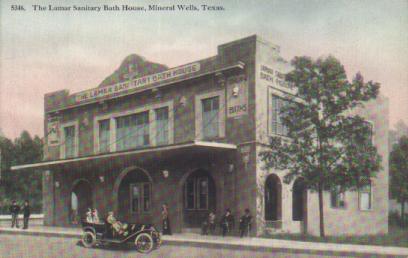
The Lamar Sanitary Bath House
Mineral Wells, Texas
(From circa 1910s postcard)
Melinda's
Wedding Day - Medley 
Victor Military Band
1913
(Victor 17362-B)
The Victor Military Band was one
of the Victor Talking Machine Company's most prominent in-house bands during
the 1910s. In addition to the marches that one would expect from
a band with such a name, the group recorded a lot of great ragtime - of
which this week's selection is an example.
In addition to "Melinda's
Wedding Day" a song called "Oh, So Sweet" is also featured during the middle
part of the recording.
Victor billed this record as "For
Dancing" and, below the title, described the song as a "One Step, Two-Step
or Turkey Trot" - all of which were popular ballroom dances during the
1900s and 1910s.
April 18, 2002
This week's Hit of the Week is brought
to you by

Rapidly attaining its manifest destiny - the
complete conquest of its market by higher quality easily recognized.
Outselling on the closest possible comparison of the four great evidences
of value - manufacturing superiority, better performance, greater beauty
and durability. Fulfilling and surpassing the promise of two
years ago that the good Maxwell would be made so good that leadership
would come to it by spontaneous public recognition.
Cord tires, non-skid front
and rear; disc steel wheels, demountable at rim and at hub; drum type lamps;
Alemite lubrication; motor-driven electric horn; unusually long springs;
new type water-tight windshield. Prices F.O.B Detroit, revenue tax
to be added: Touring Car, $885; Roadster, $885; Club Coupe $985; Four-Passenger
Coupe, $1235; Sedan, $1335.
MAXWELL MOTOR CORPORATION
DETROIT, MICHIGAN
MAXWELL MOTOR COMPAY OF CANADA,
LTD
WINDSOR, ONT.
|
(From 1923 ad)
Blue
Hoosier Blues 
Broadway Dance Orchestra
1923
(Edison 51165-R mx 8950)
This week's selection comes from
an old Edison Diamond Disc. These unique records were introduced
in 1913 and marked Thomas Edison's entry into the disc record business.
Edison was one of the greatest geniuses
of all times. Indeed, it was Edison who invented recorded sound in
1877. His business practices, on the other hand, were sometimes
rather strange to say the least.
The first decade of the 20th century
saw the rapid public acceptance of disc records at the expense of the cylinder
format originally established by Edison. Disc records were easier
to store and, with the widespread introduction of double sided disc records
in 1908, were capable of storing twice as much recorded material.
Edison, however, preferred the cylinder record for technical reasons:
the sound quality on a disc record deteriorates somewhat as the grooves
get closer to the center of the record. By 1912, Edison was
the sole remaining manufacturer of cylinder records. Not only did
he refuse to abandon the fomat, he actually introduced an improved cylinder
record which he called the Blue Amberol. In spite of a dwindling
market, Edison stood by the cylinder record and continued manufacturing
Blue Amberols until 1929 when he was forced out of the record business
by the onset of the Great Depression. In addition to his technical
reasons for prefering cylinder records, Edison was strongly opposed to
what we today would call "planned obsolescence." Edison felt that
he had an obligation to continue manufacturing records for the customers
who had purchased his cylinder phonographs.
In 1913, more than a decade after
his rivals began manufacturing disc records, Edison finally bowed to market
pressure and introduced his own version - the Diamond Disc.
These records were significantly different from the standard disc records
of the day. They were 1/4 inch thick and weighed a full pound. Their
grooves were cut using the the same vertical or "hill and dale" method
as were cylinder records - as opposed to the standard lateral cut disc
records, the patents for which were controlled by Victor and Columbia.
The grooves were also very narrow which gave the records a playing time
of up to 4 minutes. Diamond Discs had to be played with a special
diamond stylus instead of the steel needles used on standard disc machines
of the day. As a result, they could only be played on Edison machines.
Likewise, without special attachments, Edison machines were unable to play
records issued by other companies. This seriously hampered the marketability
of Edison products, especially during the 1920s when the expiration
of the patents for the lateral cut recording process resulted in a proliferation
of new record labels. Neverthless, until the introduction of electrical
recording in 1925, the sound quality of the Diamond Disc was superior to
that of any other record on the market. Edison was slow, however,
to adopt electrical recording and it wasn't until 1927 that the first electrically
recorded Diamond Discs were made.
While many great recordings were
certainly issued on the Edison label, the company was unable to compete
with its rivals in terms of attracting big name talent. Part of it
was undoubtedly due to the fact that its non-standard products had a more
limited market. But equally important was a corporate culture more
focused on technical perfection than on meeting the demands of the
marketplace. Things were even further hampered by the fact that ,
for years, no recording was issued unless it had been listened to and approved
by Edison himself - whose musical taste favored old fashioned 19th
century ballads. This is even more astonishing when one considers
the fact that Edison was almost deaf and had to bite into the cabinet
of his phonograph in order to amplify its sound vibrations.
Finally, in 1929, Edison once again
bowed to market pressure and introduced a line of standard lateral cut
78 rpm records which he called the "Needle-Cut Electric." Unfortunately,
for Edison, they were not enough to save his record enterprise from decades
of defying the marketplace. On November 1, 1929, days after the stock
market crashed, Edison gave orders for all of his phonograph operations
to be closed immediately.

I don't have a lot of information
about the Broadway Dance Orchestra. Its large number of recordings on the
Edison label makes me suspect that it was probably an in-house studio band
specializing in popular, jazz oriented selections.
EXTRA
I'm
The One 
5 Red Caps
1943
(Beacon 115-A)
One of the more frequently commented
on selections on my website is the recording of "Grand Central Station"
by the 5 Red Caps featured in my June 1998 update. When I first came
across the recording, I was unfamiliar with the group and amazed at how
"modern" it sounded for something appearing on a Gennett record - a label
that went out of business in the early 1930s. I later learned that,
for reasons of war time rationing of shellec (the material out of which
78 rpm records were made), the Gennet label was briefly revived during
the early 1940s and that it was during that period that "Grand Central
Station" was recorded. Since then, I have acquired a few more records
by the 5 Red Caps. And while their style is somewhat outside the
scope of this website, I find their recordings to be quite enjoyable and
thought that regular visitors might be interested in hearing one of them.
If you would like additional information about the group, you may find
it by clicking here.
April 11, 2002
This week's Hit of the Week is brought
to you by
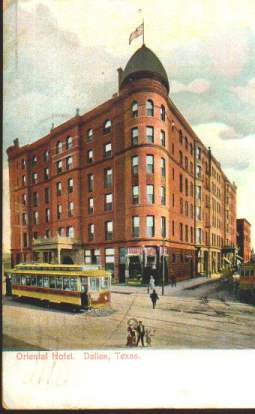
Oriental Hotel - Dallas,
Texas
(From circa 1908 postcard)
Indiana
Two-Step 
Uncredited Band
circa 1905
(Standard 50482)
NOTE: This week marks the beginning
of a slight format change for my Hit of the Week updates. Up to now,
they have focused on recordings the 1920s and 1930s with an occasional
selection from the early 1940s thrown in. Because it has been a while
since I have made any updates to the Turn of the Century section of this
website, I have decided to add some older acoustical recordings from the
1900s and 1910s to the mix.
This week's selection comes
from an old single-sided Standard Disc Record. Standard records
are unique in that they have an oversized 5/8 inch spindle hole (see photo
above). The records were pressed by Columbia for the Standard Talking
Machine Company of Chicago. Standard marketed a very popular wind-up
record player which was also manufactured by Columbia. The external
horns on the machines were often hand decorated and quite beautiful (see
example).
Standard's machines had the oversized 5/8 inch spindle so that only their
brand of records could be played on them. Sometimes, however, machine
owners tried to get around this marketing tactic - as evidenced by the
fact that one sometimes finds other brands of records from the period with
the spindle hole hand drilled out to the larger size.
Standard records drew from the Columbia
catalogue. Releases on Columbia and Standard shared the same matrix
number, which, in the early years, also doubled as the catalogue number
for both labels. Other than the larger spindle hole and the brand
information on the label, Standard records were otherwise identical to
Columbia pressings.
I don't have recording dates for
this record's matrix number series. However, comparing the disc to
Columbia records I have with known dates indicates that it was pressed
between 1904 and 1906 - though it is possible that it was recorded two
or three years earlier. An unusual matrix number series is sometimes
an indication that a selection was recorded overseas. In 1908, shortly
after Columbia introduced double sided records, this selection was reissued
on Columbia with a catalogue number of A-61 and paired with a reissue of
a 1902 recording of "Hail To The Bride March" on the flip side. The
bands on both sides of the 1908 reissue are credited simply as "Columbia
Band." It is also likely that this recording of
"Indiana Two Step" was issued on other labels pressed by Columbia
such as Sears Roebuck & Co.'s Harvard and Oxford labels as well as
the United and Harmony labels which also had oversized spindle holes.
The price listed on the back of
this record, by the way, was 6o cents. While that may not sound like a
lot of money, keep in mind that 60 cents around the turn of the 20th century
was the equivalent of around $10.70 in 2002 dollars. (See the AIER
Cost of Living Calculator) For that kind of money, buyers
got exactly what you hear: a single musical selection of less than 3 minutes
duration. Prices of wind-up record players in Sears catalogues around
that period ranged from $8.75 to $45 - or roughly between $156 and $806
in today's money. Despite the relatively high price of records, in
an age of limited home entertainment options, wind-up record players became
fixtures in the parlors of even many families of modest means. It
just goes to show how dramatically technology has expanded and lowered
the cost of our entertainment options over the past 100 years.
EXTRA
You're
Wonderful 
Nat Shilkret and the Victor Orchestra
1929
(Victor 21497-B)
Here is a record I picked up this
past weekend that I cannot resist sharing. I fell for it the moment
I listened to it and ended up playing it over again several times.
It conveys the lighthearted good cheer that was so typical of the
music of the 1920s and 1930s - and is so completely absent from today's
musical scene. Sadly, this particular copy is quite worn in spots
- undoubtedly due to a former owner failing to change the steel wind-up
phonograph needles after every playing. My audio restoration software
did a great job of cleaning it up - but there is only so much it can do
with a worn out record. Happily, Nat Shilkret records are not especially
rare so I am optimistic that I will eventually come across a copy in better
condition.
April 4, 2002
This week's Hit of the Week
is brought to you by
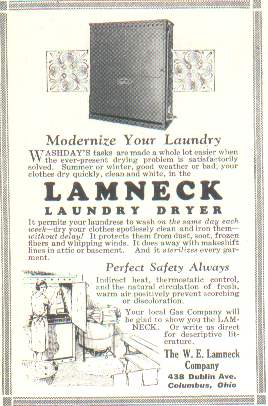
|
Modernize Your Laundry
Washday's tasks are made a whole
lot easier when the ever-present drying problem is satisfactorily solved.
Summer or winter, good weather or bad, your clothes dry quickly, clean
and white in the
LAMNECK
LAUNDRY DRYER.
It permits your laundress to wash
on the same day each week - dry your clothes spotlessly clean and
iron them - without delay! It protects them from dust, soot,
frozen fibers and whipping winds. It does away with makeshift lines
in the attic or basement. And it sterilizes every garment.
PERFECT SAFETY ALWAYS
Indirect heat, thermostatic control,
and the natural circulation of fresh, warm air positively prevent scorching
or discoloration.
Your local Gas Company will be glad
to show you the LAMNECK. Or write us direct for descriptive literature.
The W. E. Lamneck Company
438 Dublin Ave.
Columbus, Ohio
|
(From circa 1929 ad)
Me
And The Man In The Moon 
Ted Weems and His Orchestra
Arthur Jarrett, vocal
1929
(Victor 21809-A)
Because this week's record was not
in the best of shape, I had to leave in a small bit of the surface noise
to prevent the recording from being distorted by the audio restoration
software.
Ted Weems had one of the more popular
bands of the late 1920s. The band had a nice style which, happily,
has been preserved on a few CD reissues.
Vocalist Art Jarrett was the
son of Arthur L. Jarrett, an actor in silent pictures and later a screen
writer for a number of films in the 1930s and 1940s. The younger
Jarrett appeared with several bands including the Ted Weems, Red Nichols
and Earl Burtnett bands. He also played guitar, banjo and trombone.
Jarrett appeared in 20 films between 1932 and 1950, including several early
'30s musical short features in which he appeared as himself. During
his film career, he introduced several popular songs including "Everything
I Have Is Yours" (Dancing Lady 1933), "Did You Ever See A Dream
Walking" (Sitting Pretty 1933) and "Let's Fall In Love" (Let's
Fall In Love 1934). He had his own band from 1935 though the
1940s. From 1933 though 1938 Jarret was married to Eleanor Holm,
a swimmer who won a gold medal in the 1932 Olympics. He died in 1987
at the age of 80.

|



